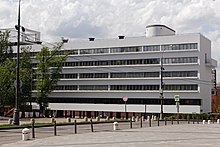Moisei Ginzburg
This article includes a list of general references, but it lacks sufficient corresponding inline citations. (May 2013) |
Moisei Yakovlevich Ginzburg | |
|---|---|
Narkomfin Building , 1929 |
Moisei Yakovlevich Ginzburg (
Biography
Education
Ginzburg (Ginsberg) was born in
Ideologist of Constructivism
The founder of the
Communal houses



The first of these was the Gosstrakh apartments (Malaya Bronnaya Street, Moscow), designed in 1926, one of which was rented by Sergei Tretyakov: these flats were the first employment of Le Corbusier's 'Five Points of Modern Architecture' in the USSR. A similar structure was built to Ginzburg's 1928 design in Sverdlovsk (21, Malysheva Street, completed 1932).
This was followed three years later by the
In 1928, Ginzburg also designed the Government Building in
Career in 1930s
Like other avant-garde artists with limited practical experience, Ginzburg fell out of favor in 1932, when the state took control of architectural profession and steered it in favor of
In the early 1930s, Ginzburg was involved in planning of Crimean Coast, designed a number of resort hotels and sanatoriums; only one of them was built in Kislovodsk (1935-1937). Ginzburg's workshop was also employed by the Ministry of Railways and designed a whole range of model stations for Central Asian and Siberian railroads. Their projects, publicized in the late 1930s, are not as bold as the 1920s avant-garde but are definitely modernist in appearance.
In the 1940s, Ginzburg produced the reconstruction plan for post-war Sevastopol (never materialized) and designed two resort buildings that were completed in Kislovodsk and Oreanda after his death.
Legacy

His most famous work, the Narkomfin Building, having been without maintenance for decades, was on UNESCO's endangered buildings list. Previous proposals to rebuild Dom Narkomfin into a hotel (designed by Ginzburg's grandson) were barred by legal uncertainty over the status of the site. As of 2019, Dom Narkomfin was under careful restoration to become once again a private residential complex. The goal was to restore the building as close to its original state as possible; restoration was completed in 2020.
Narkomfin has been the subject of Victor Buchli's study of Soviet material culture, Archaeology of Socialism (Berg, 2000), which traces the building's history from early
See also
- Constructivist architecture
- Le Corbusier
- Joseph Karakis
- El Lissitzky
- Konstantin Melnikov
- Hannes Meyer
- Vladimir Tatlin
- Bruno Taut
- Alexander Vesnin
References
- doi:10.5334/ah.264.
- JSTOR 991377.
Sources
- ISBN 978-3-933713-63-6
- Ginés Garrido: Moisei Gínzburg. Escritos 1923-1930. Madrid: El Croquis editorial 2007 ISBN 978-84-88386-43-4
- Russian: Ginzburg's railroad designs - И.Г.Явейн, "Проектирование железнодорожных вокзалов", М, 1938
- Historia de la Arquitectura Moderna, Leonardo Benévolo, Editorial Gustavo Gili, S.A., 1996 ISBN 84-252-1641-9
- Ciudad rusa y ciudad soviética, Vieri Quilici, Editorial Gustavo Gili, S.A., 1978 ISBN 84-252-0738-X
- Regional and City Planning in the Soviet Union, H. Blumenfeld, 1942
- La Montaña Mágica, Thomas Mann
